Blessed with some of the greatest natural spectacles on the planet, Botswana wildlife is some of the most varied and accessible in Africa, making it a premier safari destination. There are most elephants in Botswana than any other country, big cats roam free and there’s everything from the endangered African wild dog to aquatic antelopes and rhinos, along with abundant birdlife.
This is also the land of the Okavango Delta and the Kalahari Desert – two of the most iconic African landscapes found anywhere on the continent.
Botswana’s best national parks for wildlife are:
Central Kalahari Game Reserve
Polar opposite of the Okavango Delta, the parched Kalahari is epic in scale. One of the largest deserts in the world, yet a surprisingly good place to see some of Botswana’s most elusive wildlife. Desert adapted animals here include lions and hyenas, along with all of the shy five animals – aardvark, aardwolf, bat-eared fox, meerkat, and porcupine.
Chobe National Park
Hands down one of Africa’s best wildlife destinations, which at times can be overwhelming. If you’re after big cat viewing the Savuti area of Chobe is the place to go, whilst some of Africa’s largest elephants are found around the Chobe Riverfront area.
Makgadikgadi Pans National Park
The return of the Boteti River in recent years has multiplied the amount of wildlife found in this park. Dry season (May to October) brings one of Africa’s greatest animal migrations featuring wildebeests, zebras, and their attendant predators.
Moremi Game Reserve
Home to some of the densest wildlife concentrations on the continent in a range of habitats including woodland, savanna, and wetlands. With the reintroduction of the rhino, Moremi is now a big five reserve, and has the largest population of red lechwe in Africa, along with a healthy African wild dog population.
With this breadth and variety in mind we’ve put together a selection of the most iconic animals in Botswana to spot:
15 Iconic Animals of Botswana:
Lion

A pair of lions – the ultimate African safari animals
Leaping in at first place is the lion, also known as the king of the jungle. Lions are the largest and most sociable of Africa’s cats. At up to 225 kg, the lion (Panthera leo) really is the king of all savanna animals (not jungle!).
These big cats live in prides of up to 40 lions, and it’s the lionesses who do all the hunting, usually sharing their catches with the males of a pride. Lions are very territorial, and the females generally spend most of their lives within their home ranges.
When you hear them roaring during the night, or the day, you’ll be amazed at how loud and powerful they actually are – don’t worry about not hearing the lions snarls or roars, as they can be heard from up to 8 kilometers away. It really is a once in a lifetime opportunity to see lions hunting, or lion cubs playing with each other (but watch out for those man-eating lions!).
African Elephant
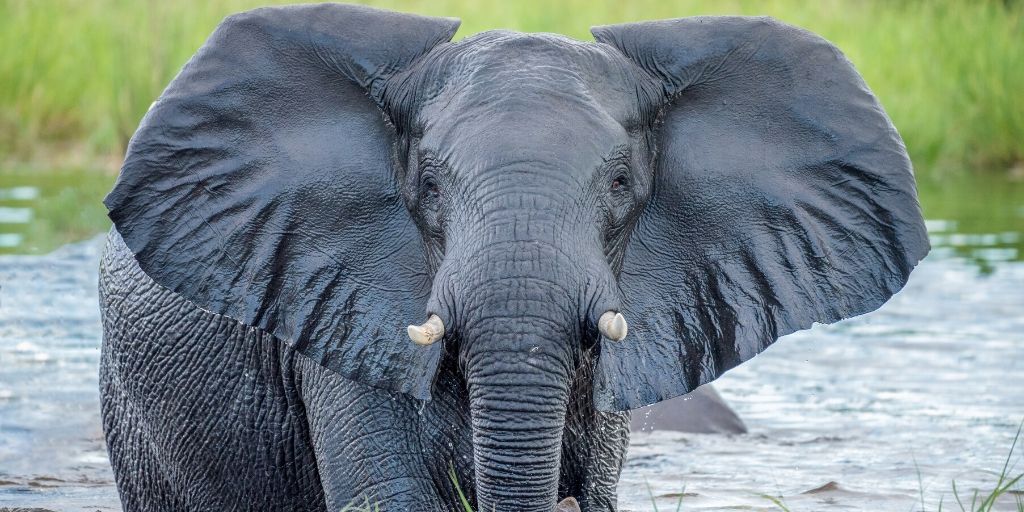
An African elephant – one of the iconic African animals
The African elephant (Loxodonta africana) is the largest land mammal and heaviest land animal in the world, weighing up to 6 tonnes. You will be stunned by the sheer size and presence of these creatures, not only on the first time you see one, but each and every time. The good news is, they’re fairly easy to spot!
Elephants play a vital role in the survival of other species by digging waterholes in dry riverbeds, spreading seeds through theirs faecal matter, and creating natural fire breaks in the landscape with their trails, and they do all this on only 2 hours sleep in a 24 hour period!
Rhinocerous

The most elusive of the big five animals?
Rhinos are something you just need to see in real life to understand how impressive they really are.
Once widespread through sub-Saharan Africa, the rhino has been hunted to the brink of extinction, and is probably the hardest of the big five animals to spot in the wild. There are two species of rhinoceros in Africa – the black rhino (Diceros bicornis) and the white rhino (Ceratotherium simum).
Whilst white rhinos have made a comeback through conservation efforts across the continent, black rhinos are still very much one of Africa’s most endangered animals, and hardest safari animals to spot. The fundamental differences between the white and black rhino are not color, but rather size, temperament, food preference, and mouth shape.
Cape Buffalo

Cape buffalo – the grumpiest of all safari animals!
Weighing in at not too far short of a ton, the African buffalo (Syncerus caffer) has a reputation for being bad-tempered and dangerous. Whilst solitary buffaloes can be unpredictable (and dangerous, hence their inclusion in the big five animals), they are usually a docile beast when in a herd… aside from their tendency to stampede en masse when alarmed.
Not sure about the differences between a bison and buffalo?
Leopard
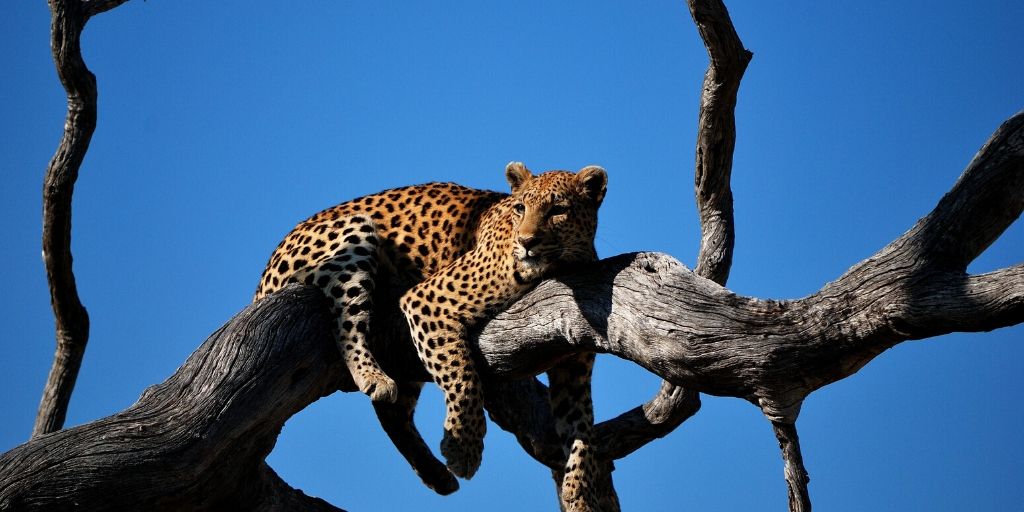
A beautiful leopard doing what it does best… lounging in a tree
The elusive leopard is one of the shyest and least sociable animals in Africa (though not one of the ‘shy five’), but are still opportunistic hunters and are highly adaptable. Watching a leopard carry its prey up a tree is a fantastic sight and one of the best African safari sightings you could hope for.
Slightly smaller than their lion cousins, leopards (Panthera pardus) are less rare than you might think, but rely on camouflage and being active at night to stay hidden.
Leopards are solitary, independent creatures, and rarely seen together except during mating, or a mother with cubs. As such they are totally self-reliant, and expert hunters – sometimes killing prey up to twice their size. During the daytime they often lounge around in trees and come to the ground after dark to hunt, taking their prey up into a tree to eat at their leisure.
Red Lechwe

Red lechwe in the Okavango Delta wetlands
The red lechwe is a medium-sized antelope, closely related to the Waterbuck. It’s adapted to marshlands and swampy territories where they browse on aquatic and semi-aquatic grasses.
These antelope are named after the reddish-brown colour on their upperparts, and have distinctly elongated hooves – an adaptation to the soggy substrate of their preferred habitats.
Spotted Hyena
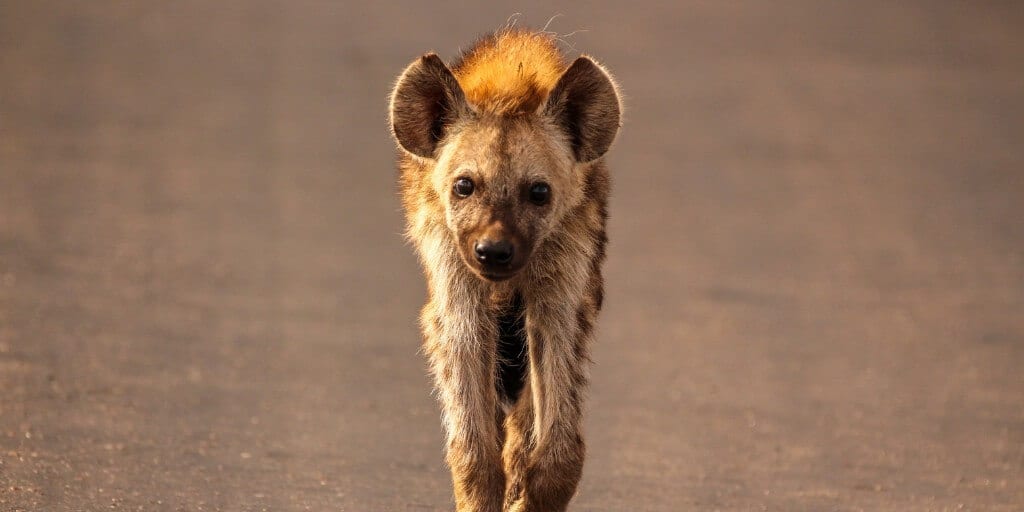
A cute hyena strolling…
There are four species in the hyena family, varying in size and shape.
Hyenas are unique and vital components of most African ecosystems, both taking advantage of other animals’ kills for easy meals and hunting themselves. The size of a hyena kill or scavenge is generally determined by the size of the hyena’s clan, which can run to dozens. They often hide extra food in watering holes, since nothing is wasted. Hyenas eat every part of an animal, including bones and hooves.
Hippo

A hippo – one of Africa’s most dangerous animals
Spending most of their days keeping cool in the water or mud, hippos are semi-aquatic safari animals. They resemble large pigs but are in fact related to the whale species, and despite their large, cumbersome appearance can easily outrun a human, and are known as one of Africa’s most dangerous animals.
Zebra

Zebras at a waterhole
Zebra are perhaps the most stylish of African animals, with their characteristically stunning coats of black and white stripes. These distant relatives of the horse are a frequent sight on any African safari and consist of three different species.
There are many theories about why zebras have stripes, and it seems that perhaps the most likely answer is that the stripes function as a way to deter biting insects like tsetse flies and mosquitos.
Plains zebras play a particularly interesting role in the ecosystem, as they are pioneer gazers, nibbling and feeding on the top-most layer of grass, thereby opening up the grassland for more specialized grazers looking for the short grasses tucked below.
Giraffe
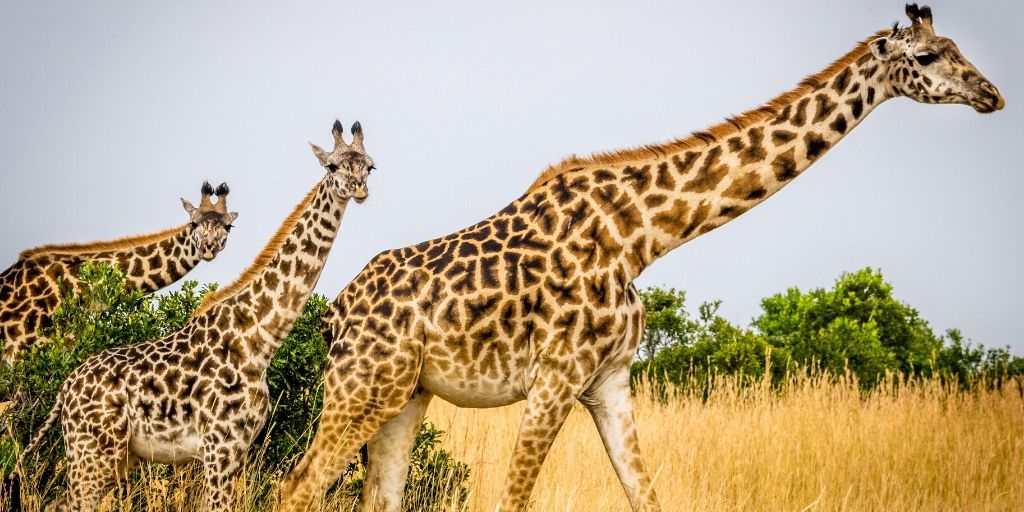
Giraffe mother with two young
Perhaps the ultimate icon of the African savanna, the giraffe is an unmistakable land mammal known for their long necks and spotted coat (and super-weird giraffe tongue!). They were known by Arab prophets as the ‘queen of the beasts’ because of their delicate features and graceful poise.
With nine subspecies sharing its distinctive characteristics, this African safari animal is the tallest in the world by some way, and amongst the heaviest and largest animals anywhere. The giraffe’s coat is characterized by dark blotches on lighter hair. With age, male giraffes may become darker, and while calves inherit spot patterns from their mothers, each giraffe has a unique coat pattern that sets it apart.
Giraffes have a sharp sense of hearing and smell, another defense against predators, while it can close its nostrils during sandstorms and against ants.
Aardvark
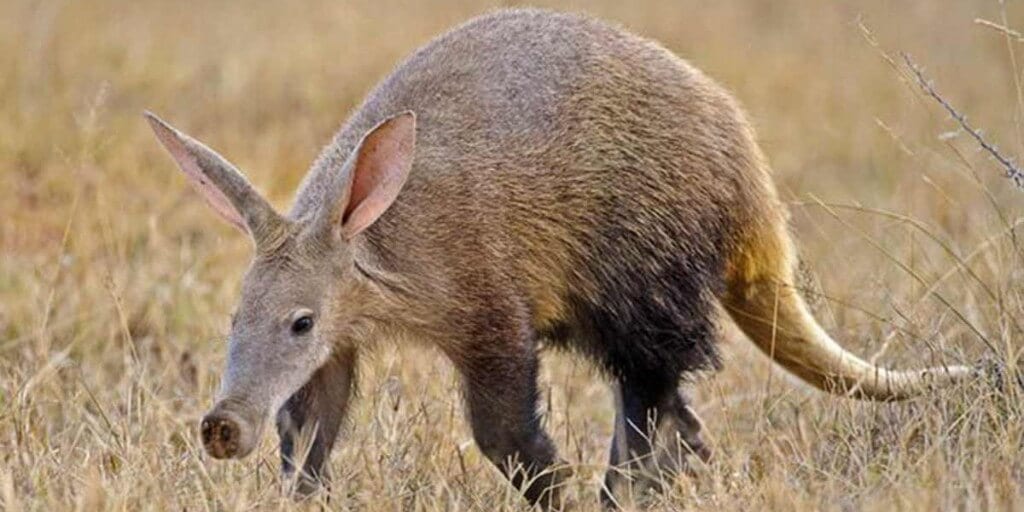
An adult aardvark in the grass
Aardvarks live throughout Africa, south of the Sahara. Their name comes from South Africa’s Afrikaans language and means ‘earth pig’. Being nocturnal, they spend the hot African afternoons resting in their cool underground burrows, and night time foraging in grasslands and forests for termites.
Aardwolf
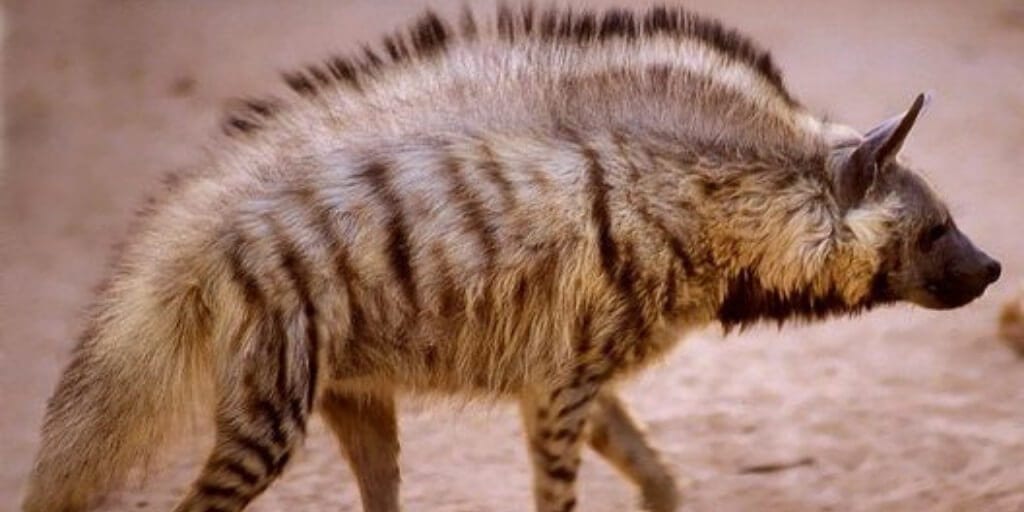
The elusive aardwolf
Aardwolves are nocturnal, solitary foragers, only coming together to mate and rear young. . The name Aardwolf means ‘earth wolf’ in Afrikaans and stems from its supposed dog-like features and its diet of termites which it digs for in the ground and in the termite mounds.
Bat-eared Fox
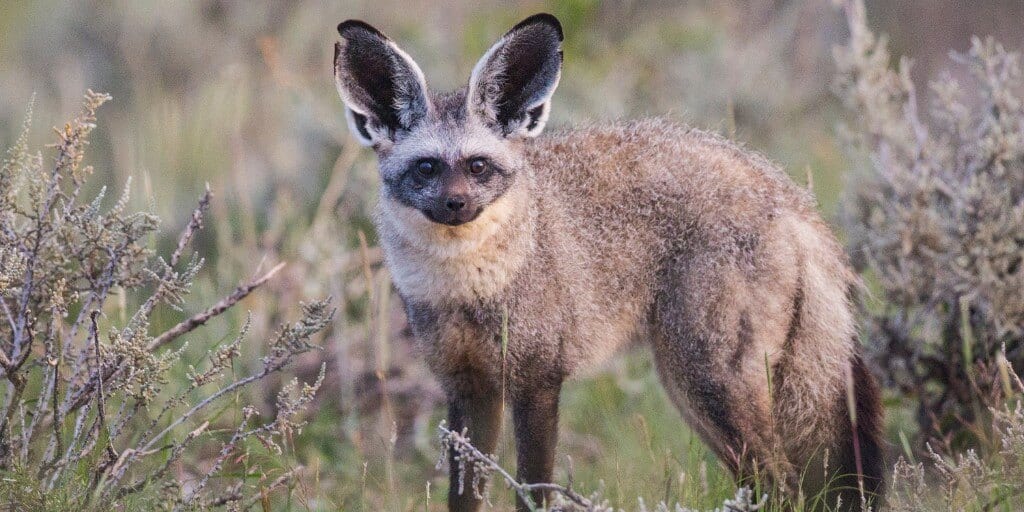
Can you see how it got its name?
As the name indicates, this fox has unusually enormous ears in proportion to its head, like those of many bats. Their bodies are generally yellow-brown with a pale throat and under parts. Bat-eared foxes are primarily found in East and Southern Africa where there are short-grass plains and plenty of termites and beetles.
Meerkat
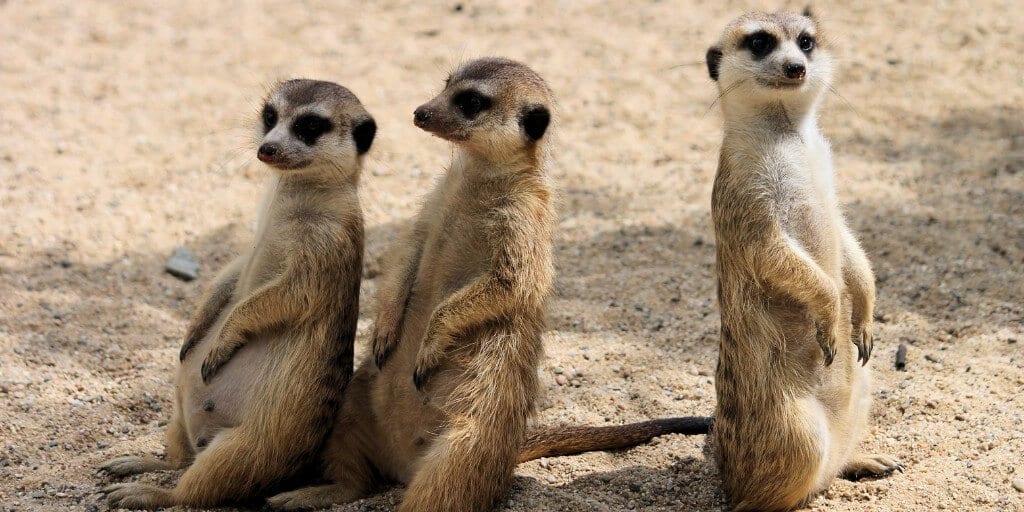 A family of meerkats
A family of meerkats
The meerkat, or suricate, is a small carnivoran in the mongoose family. It is the only member of the genus Suricata. Meerkats are predominantly desert animals and live in all parts of the Kalahari Desert in Botswana, in much of the Namib Desert in Namibia and southwestern Angola, and in South Africa.
African Wild Dog
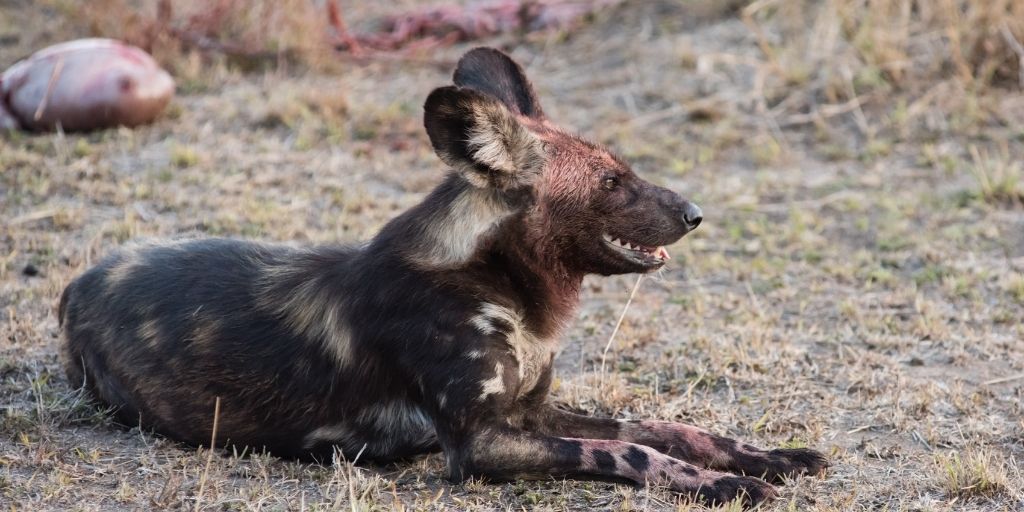
Wild dog with bloody face
The African wild dog is one of the most successful hunters on the African plains, and are highly social and intelligent animals. These characteristics have made the painted wolf be arguably the most successful hunter on Africa’s dangerous plains.
So there you have our take on the 14 most iconic species of Botswana wildlife you could expect to see when on safari in Botswana. What do you think – any controversial picks… or Botswana wildlife that are missing from the list? Let us know in the comments section below!
If you’re looking for more in-depth information on any of these – or other – African animals, you can check out our animal lists or animal comparisons.

you did a good job on this is really nice.
you should do more like this.